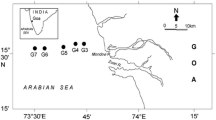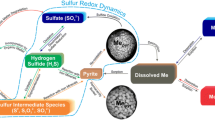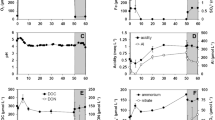Abstract
In an oligotrophic moorland pool in The Netherlands, S cycling near the sediment/water boundary was investigated by measuring (1) SO4 2− reduction rates in the sediment, (2) depletion of SO4 2− in the overlying water column and (3) release of35S from the sediment into the water column. Two locations differing in sediment type (highly organic and sandy) were compared, with respect to reduction rates and depletion of SO4 2− in the overlying water.
Sulfate reduction rates in sediments of an oligotrophic moorland pool were estimated by diagenetic modelling and whole core35SO4 2− injection. Rates of SO4 2− consumption in the overlying water were estimated by changes in SO4 2− concentration over time in in situ enclosures. Reduction rates ranged from 0.27–11.2 mmol m−2 d−1. Rates of SO4 2− uptake from the enclosed water column varied from −0.5, −0.3 mmol m−2 d−1 (November) to 0.43–1.81 mmol m−2 d−1 (July, August and April). Maximum rates of oxidation to SO4 2− in July 1990 estimated by combination of SO4 2− reduction rates and rates of in situ SO4 2− uptake in the enclosed water column were 10.3 and 10.5 mmol m−2 d−1 at an organic rich and at a sandy site respectively.
Experiments with35S2− and35SO4 2− tracer suggested (1) a rapid formation of organically bound S from dissimilatory reduced SO4 2− and (2) the presence of mainly non SO4 2−-S derived from reduced S transported from the sediment into the overlying water. A35S2− tracer experiment showed that about 7% of35S2− injected at 1 cm depth in a sediment core was recovered in the overlying water column.
Sulfate reduction rates in sediments with higher volumetric mass fraction of organic matter did not significantly differ from those in sediments with a lower mass fraction of organic matter.
Similar content being viewed by others
References
Andrews D & Bennet A (1981) Measurements of diffusivity near the sediment-water interface with a fine-scale resistivity probe. Geochim. et Cosmochim. Acta. 45: 2169–2175
Archie GE (1942) The electrical resistivity log as an aid in determining some reservoir characteristics. Trans. Am. Inst. Min. Metall. Pet. Eng. 146: 54–62
Bak F, Scheff G & Jansen KH (1991) A rapid and sensitive ion chromatographic technique for the determination of sulfate and sulfate reduction rates in freshwater lake sediments. FEMS Microbiology Ecology 85: 23–30
Baker LA, Urban NR, Brezonik PL & Sherman LA (1989) Sulfur cycling in an experimentally acidified seepage lake, pp. 79–100. In: Saltzman ES & Cooper WJ (Ed) Biogenic Sulfur in the Environmetnt. Am. Chem. Soc., Washington, DC
Berner RA (1964) An idealized model of dissolved sulfate distribution in recent sediments. Geochim. Cosmochim. Acta. 28: 1497–1503
Berner RA (1980) Early diagenesis: A theoretical approach. Princeton
Canfield DE, Raiswell R, Westrich JT, Reaves CM, & Berner RA (1986) The use of chromium in the analysis of reduced inorganic sulfur in sediments and shales. Chemical Geology 54: 149–155
Carignan R (1988) Seasonal dynamics of sulfate and hydrogen sulfide near the sedimentwater interface of an oligotrophic acid lake. Verh. Internat. Verein. Limnol. 23: 106–115
Cook RB, Kelly CA, Schindler DW & Turner MA (1986) Mechanisms of hydrogen ion neutralization in an experimentally acidified lake. Limnol. Oceanogr. 31: 134–148
Duursma EK & Bosch CJ (1970) Theoretical, experimental and field studies concerning diffusion of radioisotopes in sediments and suspended particles of the sea. Netherlands J. Sea Res. 4: 395–469
Feijtel TC, Salingar Y, Hordijk CA, Sweerts JPRA, Van Breemen N & Cappenberg ThE (1989) Sulfur cycling in a Dutch moorland pool under elevated atmospheric S-deposition. Water, Air and Soil Pollution 44: 215–234
Ferdelman TG, Church TM & Luther III GW (1991) Sulfur enrichment of humic substances in a Delaware salt marsh sediment core. Geochim. Cosmochim. Acta 55: 979–988
Fossing H & Jørgensen BB (1989) Measurement of bacterial sulfate reduction in sediments: Evaluation of a single-step chromium reduction method. Biogeochemistry 8: 205–222
Francois R (1987) A Study of sulphur enrichment in the humic fraction of marine sediments during early diagenesis. Geochim. Cosmochim. Acta 51: 17–27
Giblin AE, Likens GE, White D & Howarth RW (1990) Sulfur storage and alkalinity generation in New England lake sediments. Limnol. Oceanogr. 35: 852–869
Herlihy AT & Mills AL (1989) Factors controlling the removal of sulfate and acidity from the waters of an acidified lake. Water, Air and Soil Pollution 45: 135–155
Hordijk CA, Hagenaars CPMM & Cappenberg TE (1984) Analysis of sulfate at the mudwater interface of freshwater lake sediments using indirect photometric chromatography. J. Micr. Methods 2: 49–56
Hordijk KA, Hagenaars CPMM & Cappenberg TE (1985) Kinetic studies of bacterial sulfate reduction in freshwater sediments by high-pressure liquid chromatography and microdistillation. Appl. Environ. Microbiol. 49: 434–440
Ingvorsen K, Zeikus JG, & Brock TD (1981) Dynamics of bacterial sulfate reduction in a eutrophic lake. Appl. Environ. Microbiol. 42: 1029–1036
Jørgensen BB (1978) A comparison of methods for the quantification of bacterial sulfate reduction in coastal marine sediments I. Measurement with radiotracer techniques. Geomicrobiology Journal 1: 11–27
Jørgensen BB & Fenchel T (1974) The sulfur cycle of a marine model system. Marine Biology 24: 189–201
Kelly CA & Rudd JWM (1984) Epilimnetic sulfate reduction and its relationship to lake acidification. Biogeochemistry 1: 63–77
Kuivila KM, Murray JW, Devol AH & Novelli PC (1989) Methane production, sulfate reduction and competition for substrates in the sediments of Lake Washington. Geochim. Cosmochim. Acta 53: 409–416
Li YH & Gregory S (1974) Diffusion of ions in sea water and in deep-sea sediments. Geochim. et Cosmochim. Acta 38: 703–714
Nriagu JO & Soon YK (1985) Distribution and isotopic composition of sulfur in lake sediments of nothern Ontario. Geochim. Cosmochim. Acta 49: 823–834
Rudd JWM, Kelly CA & Furutani A (1986a) The role of sulfate reduction in long term accumulation of organic and inorganic sulfur in lake sediments. Limnol. Oceanogr. 31: 1281–1291
Rudd JWM, Kelly CA, Louis VSt, Hesslein RH, Furutani A & Holoka MH (1986b) Microbial consumption of nitric and sulfuric acids in acidified north temperate lakes. Limnol. Oceanogr. 31: 1267–1280
Schiff SL & Anderson RF (1987) Limnocorral studies of chemical and biological acid neutralization in two freshwater lakes. Can. J. Fish. Aquat. Sci. 44: 173–187
Schimmel HJW & Hoeve ter J (1952) Bodemgesteldheid en waterhuishouding van de ‘Gerritsflesch’ bij Kootwijk. Tijdschrift van het Koninklijk Nederlandsch Aardrijkskundig Genootschap deel LXIX, No 1
Schindler DW, Turner MA, Stainton MP & Linsey GA (1986) Natural sources of acid neutralizing capacity in low alkalinity lakes of the Precambrian shield. Science 232: 844–847
Sinke AJC, Cornelese AA, Keizer P, Van Tongeren OFR & Cappenberg TE (1990) Mineralization, pore water chemistry and phosphorous release from peaty sediments in the eutrophic Loosdrecht lakes, The Netherlands. Freshw. Biol. 23: 587–599
Sweerts JPRA, Louis VSt, & Cappenberg TE, (1989) Oxygen concentration profiles and exchange in sediment cores with circulated overlying water. Freshw. Biol. 21: 401–409
Sweerts JPRA, Kelly CA, Rudd JWM & Cappenberg TE (1991) Similarity of wholesediment molecular diffusion coefficients in freshwater sediments of low and high porosity. Limnol. Oceanogr. 36: 335–342
Van Dam H (1987) Acidification of moorland pools: a process in time. Ph.D. dissertation. Agricultural University Wageningen, The Netherlands
Van Dam H, Van Geel B, Van Der Wijk A, Geelen JFM, Van Der Heijden R & Dickman MD (1988) Paleolimnological and documented evidence for alkalization and acidification of two moorland pools (The Netherlands). Review of Paleobotany and Palynology 55: 273–316
Wieder RK & Lang GE (1988) Cycling of inorganic and organic sulfur in peat from Big Run Bog, West Virginia. Biogeochemistry 5: 221–242
Author information
Authors and Affiliations
Additional information
Corresponding author
Rights and permissions
About this article
Cite this article
Marnette, E.C., Horditk, C., Van Breemen, N. et al. Sulfate reduction and S-oxidation in a moorland pool sediment. Biogeochemistry 17, 123–143 (1992). https://doi.org/10.1007/BF00002643
Received:
Accepted:
Issue Date:
DOI: https://doi.org/10.1007/BF00002643




